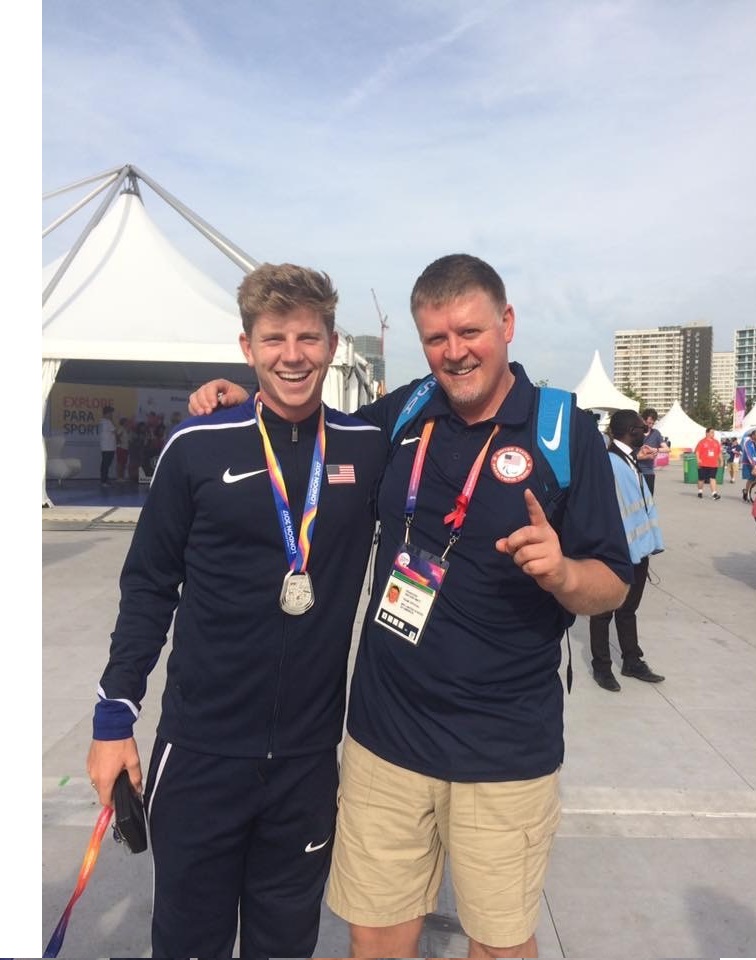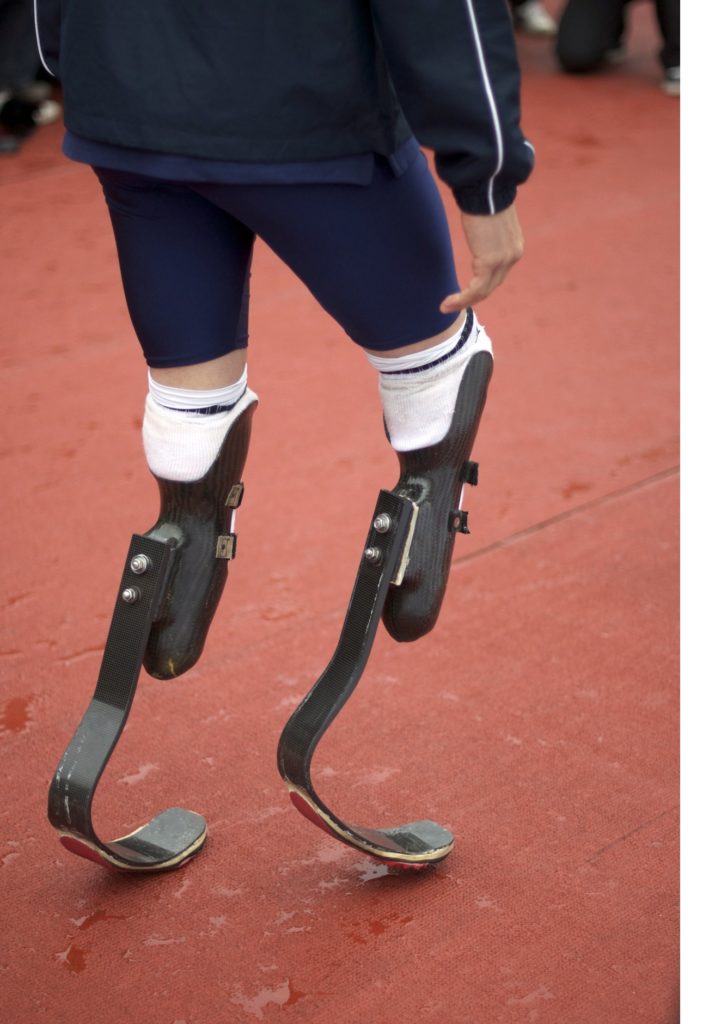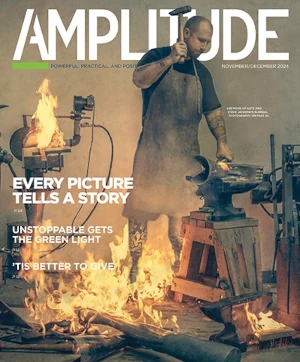Hunter Woodhall is one of the biggest stars and most recognizable faces on the US Paralympics team. Amplitude got to know Hunter pretty well last year, with a feature about his unique relationship with fellow NCAA track star Tara Davis and the megasuccessful YouTube channel they operate together (173,000 subscribers and counting).
We’ll be talking to Hunter regularly throughout 2020 as he prepares for his second Paralympic Games and pursues his first gold medal(s) in track and field. This conversation took place in late February, after Hunter wrapped up a long weekend with prosthetist Francois Van Der Watt.
You texted the other day that you were building new legs this weekend. Does that mean you’re hands-on in this process?
Yeah, absolutely. So, a good friend of mine does all my legs, especially on the running leg side. He worked with Oscar Pistorius and a lot of the other prominent blade runners throughout history. We’ve been working together since 2014. He’s only about an hour and a half away from where I go to school [at the University of Arkansas], so I can get up there pretty easily. And when we work on new legs, yeah, I’m 100 percent right there next to him. Obviously he’s doing most of the technical stuff, but I help out as much as I can.
What is this guy’s name?
His name is Francois Van Der Watt. He’s South African, but he’s been living in the US for most of two decades now. I believe he just completed his US citizenship as well. He was in Georgia first, and then they moved to Fort Smith, Arkansas.

at the 2016 Paralympics in Rio De Janeiro
Was that one of the big attractions to run for the University of Arkansas—to be in proximity to Francois?
Oh yeah, without a doubt. He’s the only person I knew in Arkansas when I moved here. He’s always been a really good friend of mine, so just to be able to have that access to someone who you trust working on one of the most integral parts of racing, that’s an extreme advantage.
How did you get to know each other?
He actually was the official prosthetist for Team USA going into Worlds in 2015. There was a training camp in California in 2014 where we met, and we kind of just went through my alignment and how my legs were set up. We made just a few changes, and the difference was astronomical. He knows what he’s talking about, he’s very well versed in what he’s doing, and he’s just a great guy to be around.
By now the chemistry between us is very good. We’re very comfortable with each other, with how we work and what we’re looking for in a leg. It’s one of the reasons I like working with him so much.
When you say you’re “building new legs,” does that mean you’re starting from scratch? Are you taking an existing pair of legs and making some adjustments and tweaks? Walk me through that process.
We start from scratch. Everything is from scratch. The only thing that comes that’s already done is the actual foot. So the foot we get from a company called Ossur, who I get all of my running blades from.
Usually this process would take one to two weeks—coming in and out, fitting, testing, all that sort of stuff. But we put in three days in a row, 10-hour days, to just grind it out. You start with a cast of your leg, and you fill it with a mold, and you make a test socket out of that to make sure the alignment’s right. And then you go into the fabrication process. So there’s a lot of technical work that has to be done, and then there’s a lot of waiting around.
What’s the thought process that you go through before you get started? Do you come up with a specific set of characteristics that you’re trying to build into the legs?
Francois has made all the last iterations of my running prosthetics dating back however many years. So now we’re to a point where rather than trying to reinvent the wheel, we’re just trying to get as close as possible to what we had previously. A lot of times you’re getting new legs because the fit’s wrong or the blade’s just gone soft or it just kind of needs a revamp.
With these new legs, our goal was to make them lighter. I had my old legs for so long that we had to do a lot of patchwork. So there was a lot of external casting on them—we had to add layers of fiberglass and carbon fiber, and it really increased the weight of the legs. With the new legs, on the right leg we’re actually 11 ounces lighter than the old one. On the left leg, about 5 ounces lighter. It doesn’t seem like a lot, but in running that’s a ton.

at the 2012 Summer Olympics in London.
Are there strict regulations you have to follow in terms of what materials you can use, that are imposed by either the international committees or the NCAA?
The basic rule of thumb for international competition, especially the Paralympics, is that if the technology is available on the market to anyone, you can use it. You’re good to go. Where I run into a problem is that I also run able-body [in NCAA competition]. So we have to put in an appeal every year and specify exactly what blades we’re running on, what height, all these things. I have a very limited amount of choices that I can pick, where I’m not doing something that would be viewed as an unfair advantage. So the setup I have now, which is the same setup I’ve been using since my freshman year of high school, is the way that it is because I’m running able-body and I want to keep doing that. And this setup has been tested and puts me in a spot where there are no questions about whether I’m running a fair race.
After the collegiate season, when I’m going into Tokyo, we’re planning on making that upgrade and going to the blades and technology that everyone else is using on the Paralympic level. So any time I’m running able-body I’ll go back to the original setup that I’ve always been on. But when we go to the Paralympic side, we have to be able too compete on a level playing field. And the way to do that is to go to what everyone else is running on.
I’ve always competed internationally with my able-body setup, and I’ve done just fine. But this year is really about excelling and showing all the hard work we’ve put in, and doing everything we can to maximize performance.
So in the 2016 Paralympics, you won medals with the same legs you use in competition against able-bodied runners?
Yep.
Are the legs you worked on this weekend the ones you’re planning to take to Tokyo? Or are these to run against able-bodied runners in NCAA competition?
These will be able-body. We leave for the SEC Indoor Conference Championships this coming Wednesday, so we knew we needed to get them done. [The conference meet took place this past weekend, February 28-29.] That’s why we really rushed the process to get them done. As far as specs, everything is exactly the same as the last set. The only difference is they’re lighter, and there’s a new foot on them, so it’s going to be less worn out.
When you change from the legs you run on in able-body competition and shift to legs that are engineered differently for international Paralympic competition, is that a difficult adjustment? Does it change the mechanics of how you run, or your feel for the track? Does it change the way that you train?
I wish I could give you a better answer, but the best answer I can give you right now is: We haven’t done it. I’ve been set on the idea that I want to stay consistent where I’m running, and I avoid going back and forth between Paralympic and able-body. So I’ve always been running on kind of a downgraded system, I guess you could call it. But in seeing how technology is advancing, it just doesn’t make sense. A NASCAR driver wouldn’t not put in a new, better engine if they had the ability to.
So we are going to change for Tokyo, and at the end of the day it is a very different blade. It is going to change my mechanics, how I train, how I run. The basis for changing a foot is the energy displacement and the energy return from that blade. That’s what’s going to be different. We need to do some more testing when we get the feet on me, but with higher energy return, better general energy return, ground contact time—all these things add up very quickly to improved performance.
We ordered some of the new blades, the new designs from Ossur, and we got in two different iterations of them. We picked the one we thought would be better, so we’re going to try it out and see how it is. After indoor NCAAs end, we’ll just kind of see what happens. Because like I said, we don’t really know. We’ve been running on the same feet for five, six years.
We’ll have to figure out what I run best in. We’re not even sure what that is yet. So once we figure it out, going into trials for Tokyo, we’re going to be in the best position we can be in to succeed.



